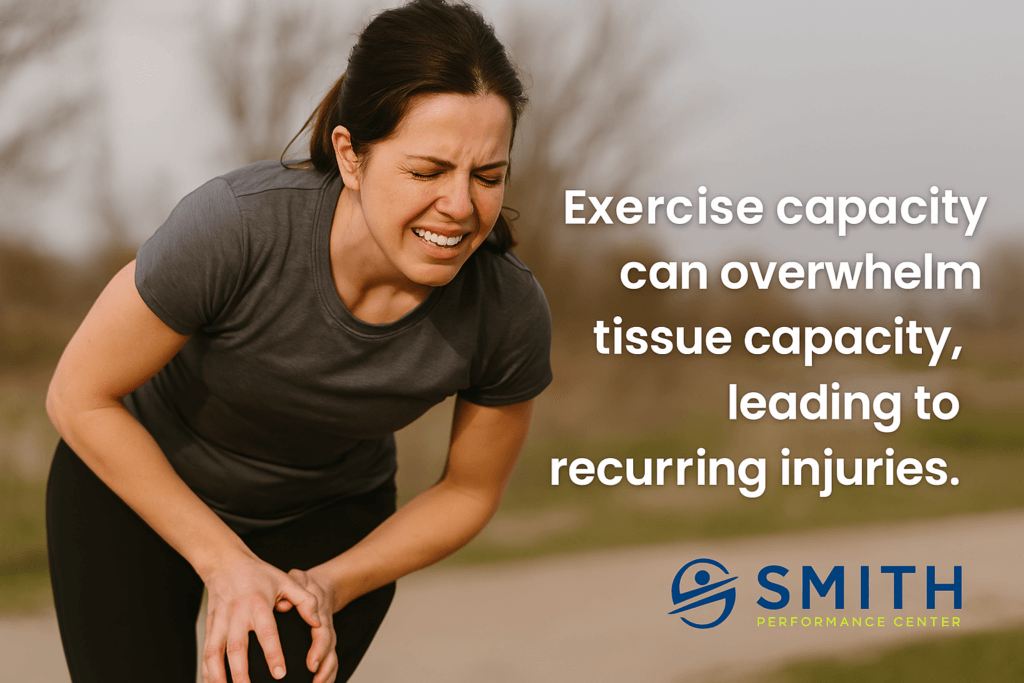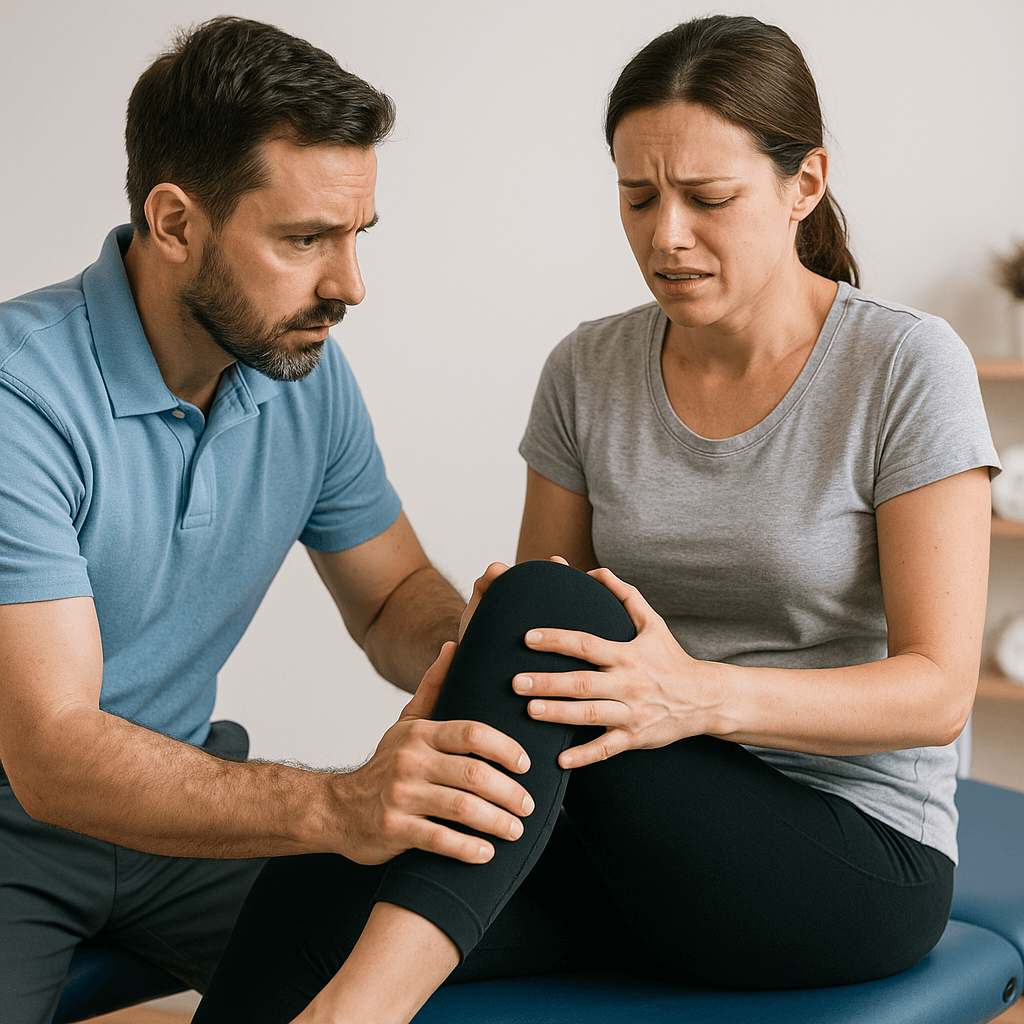You’re Doing the Work—So Why Does Your Body Keep Breaking Down?
You show up. You put in the effort. Whether it’s running, lifting, group fitness, or weekend hikes, you’re trying to stay active. But despite the commitment, you keep dealing with recurring injury from exercise. Pain shows up, progress stalls, and your body feels more unpredictable than it should.
This isn’t about motivation. It’s about biology.
The real issue is a mismatch between what you can make yourself do and what your body is built to tolerate.
At Smith Performance Center, we call that gap the difference between exercise capacity and tissue capacity the rehab standard—and it’s one of the most overlooked problems in rehab and training.

What Is Exercise Capacity?
Exercise capacity is your ability to push through effort and accumulate work over time. It’s what most people think of as “fitness.” It includes:
- Your endurance and cardiovascular output
- The amount of work you can do in a single session
- Your ability to maintain effort across multiple days or weeks
- Your mental toughness and ability to grind through discomfort
- How much you can do when you’re motivated
Exercise capacity reflects what you’re capable of forcing your body to do in the moment and over a period of time—whether or not your body is truly prepared for it.
What Is Tissue Capacity?
Tissue capacity is a more honest measure of what your body can sustainably handle without a bad response. It includes:
- The physical resilience of your muscles, tendons, joints, and connective tissues
- The cumulative load from past workouts, stress, lack of sleep, and poor recovery
- Your body’s biological readiness to adapt to stress
- The nervous system’s threat response—in some individuals, pain occurs not because of tissue damage, but because the brain interprets certain movements as dangerous
Tissue capacity is the ceiling for sustainable performance. Exceed it, and you pay for it—sometimes immediately, often with delayed symptoms.
It’s the Gap That Creates Problems
Here’s the important point: both undertrained and highly trained individuals can have a mismatch between exercise and tissue capacity.
1. The Experienced Pusher
- History of regular training or sport
- High motivation and mental toughness
- Pushes through discomfort routinely
- Often carries unresolved injuries or imbalances
Their exercise capacity is high—but tissue capacity lags behind. These individuals can do more than their body can recover from. Injuries often feel like bad luck, but they’re the result of repeated overload.
Think of the runner, weight lifter, or weekend warrior that gets 1-2 months of training before that ‘bad back’ sidelines them again.
2. The Eager Beginner or Returning Exerciser
- Low baseline tissue capacity due to inactivity or life stress
- Eager to make quick progress
- Starts with a plan that’s too intense for their current state
In these cases, both capacities are low—but expectations exceed reality. The body simply hasn’t built the foundation yet.
In both cases, its the gap and a violation of the rehab standard (See how we address this gap using the SPC Phase System).
This mismatch shows up as:
- Recurring pain
- Setbacks when volume or intensity increase
- Delayed soreness or stiffness
- A cycle of progress, flare-up, repeat
- Reliance on recovery tools just to keep going
It’s not a question of effort.
It’s a question of alignment.
What the Research Tells Us About Load Tolerance and Recurring Injury from Exercise
The mismatch between what your body can tolerate (tissue capacity) and what you’re doing (exercise capacity) isn’t just a theory—it’s supported by a growing body of research in sports medicine, rehabilitation, and pain science.
Here are some key findings that support this concept:
1. Sudden Increases in Load Increase Injury Risk
Research by Tim Gabbett and others has shown that rapid spikes in workload are a key predictor of injury. Athletes (and active individuals) who increase training too quickly—beyond what their tissues are prepared for—are more likely to experience breakdowns. This reinforces a key principle: more training is only better if your physical (tissue) capacity is already developed. Without that foundation, higher training loads increase risk rather than resilience.
2. Recovery and Tissue Adaptation Are Not Linear
Tissues respond to stress through adaptation, but they also require recovery time. Workload tolerance is influenced by sleep, nutrition, stress, and prior injury—factors that vary daily.
3. Pain Is Not Always Proportional to Tissue Damage
For individuals with chronic or recurring pain, research in pain science has consistently shown that pain can persist even in the absence of tissue pathology, due to nervous system sensitization or maladaptive protective responses.
Moseley & Butler (2017). Explain Pain Supercharged.
4. Both Inactive and Active Populations Are at Risk
Studies show that both sedentary individuals and highly active individuals are vulnerable to injury when their activity exceeds their tissue’s preparedness. The risk isn’t limited to elite athletes—it’s about how load is managed relative to the individual’s baseline.

FAQ: Understanding Tissue Capacity, Injury Risk, and Long-Term Progress
Q: What is tissue capacity in rehab and training?
A: Tissue capacity refers to your body’s ability to tolerate stress—such as training load, poor sleep, daily stress, and repetitive movement—without breaking down or exhibiting a bad response that stops you. It includes muscles, tendons, joints, and the nervous system.
Q: What is the difference between tissue capacity and exercise capacity?
A: Exercise capacity is what you can make yourself do—based on fitness, willpower, and mental drive. Tissue capacity is what your body can tolerate without breaking down. If the two don’t match, pain and injury are more likely. Training that is focused on exercise capacity when tissue capacity is the limitation is called violating the rehab standard and the gap between the two is often why you get stuck in an injury doom loop.
Q: Why do I keep getting injured even though I’m strong and fit?
A: You likely have a mismatch between your high exercise capacity and lower tissue capacity. You can do the work, but your tissues haven’t fully adapted to recover from it. This is especially common in experienced athletes and high-performing individuals.
Q: Can I build tissue capacity?
A: Yes. Tissue capacity can be improved through consistent, graded exposure to load, strength training, better recovery, and identifying contributing factors like movement inefficiencies or nervous system sensitivity.
Q: Do I need to stop training to increase tissue capacity?
A: Not necessarily. The goal isn’t to stop moving—it’s to train smarter. You may need to reduce intensity, manage frequency, or adjust load, but movement is part of the solution. Programs like the SPC Phase System are designed to rebuild capacity without stopping everything.
Q: What if my pain doesn’t match any injury?
A: You may be experiencing a heightened threat response from your nervous system. This is common in chronic or recurring pain and doesn’t mean you’re imagining it. It means your body is interpreting certain loads or movements as dangerous, even if no structural damage exists.
Q: Who is this concept most important for?
A: Anyone dealing with recurring injuries—especially when those injuries seem to return despite rest, rehab, or strong motivation to train.
This includes (but isn’t limited to):
- Athletes with a history of overtraining
- Athletes with significant training history at a high level
- Motivated individuals pushing far beyond their recent training baseline
- People returning to exercise after time off
- Knowledge workers starting a new fitness program after years of sedentary routines
- Individuals with chronic pain that doesn’t match imaging or clinical exam findings
If your body keeps breaking down even though you’re “doing the right things,” this concept applies to you.
Final Takeaway
If you keep breaking down despite working hard, the issue isn’t your motivation—it’s the mismatch between your tissue’s readiness and your training or lifestyle demands.
You don’t need to train harder. You need tissue that can handle what you already do. Switch to a focus on good responses to your workouts.
Can We Help?
Tired of running into the same wall with training or recovery?
Don’t just rehab—rebuild smarter with a system that puts tissue capacity first.
Schedule a Movement Assessment or Physical Therapy Evaluation at Smith Performance Center to start your injury-free comeback today.



